DeepSeek vs. ChatGPT: How Do They Compare?
- February 4, 2025
- 13 mins read
- Listen
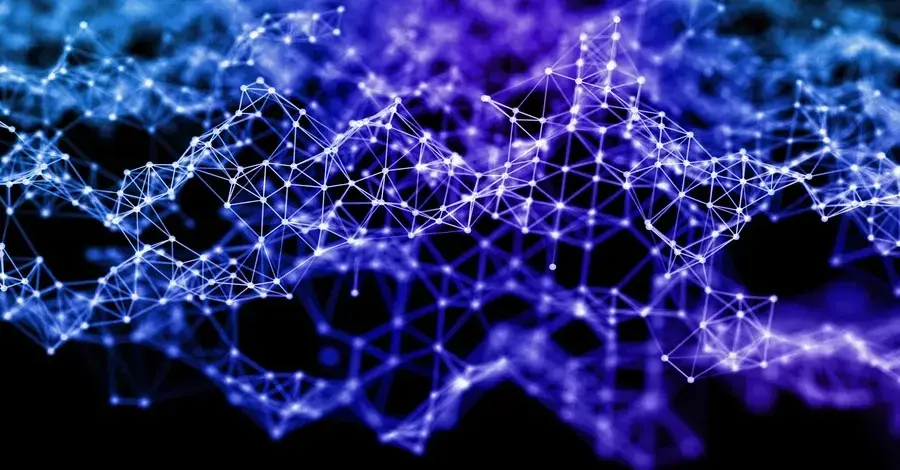
Table of Content
The AI world underwent a huge industrial shift after the release of DeepSeek. As a new reasoning model, DeepSeek R1 is showing a lot of promise as an AI model, and many people are reaping the benefits of that. Thus, this has brought about the conversation as to which platform is better: DeepSeek or ChatGPT.
With such a revolutionary chatbot, it is understandable that Deepseek is being compared to a giant like ChatGPT. Both serve the same purpose as AI chatbots, capable of answering questions, creating content, and so on.
However, there are some key differences between the two. So, let’s take a deeper look and compare Deepseek and ChatGPT in terms of features and use cases.
Differentiating Between DeepSeek and ChatGPT
As we are comparing both DeepSeek and ChatGPT, let’s first talk about both platforms a bit.
ChatGPT is an AI chatbot created by OpenAI that is capable of providing general answers or generating well-structured content. As a platform, Chatbot excels really well at conversations, learning and adapting to a user’s preferences to generate quality answers.
On the other hand, Deepseek is another AI chatbot that is a more specialized version. Based on all the information available about their model and testing done by us, Deepseek looks to be extremely efficient at mathematical and technical issues.
Both use Large Language Models to power themselves to learn from new datasets and information. Also, both models provide concise solutions to your queries, just in different ways.
Hence, you can draw a pretty good distinction between ChatGPT and DeepSeek. ChatGPT is optimized for general-purpose content and conversations due to its deep knowledge base. Meanwhile, Deepseek is more tuned to answer technical and industry-specific questions with ease while being extremely cost-efficient.
Comparing DeepSeek and ChatGPT
Both AI models have a lot to offer and have distinct features that are better than their counterparts. Here is a table highlighting that.
| Specifications |
DeepSeek |
ChatGPT |
|
Architecture |
Uses Mixture of Elements (MoE) |
Uses Traditional Transformer Model |
|
Reasoning Model |
Learns through Reinforcement |
Mixture of Reinforcement and chain-of-thought |
|
Performance |
Great for Technical Queries |
Consistent Performance For General Queries |
|
Speed |
Fast, Especially For Structured Questions |
Fast but Technical Task Resolution Can be Slower |
|
Customization |
Extensive but Requires Technical Expertise |
Limited But Easy to Do |
|
Source Policy |
Open Source (DeepSeek R1) |
Closed Source |
|
API Pricing (per million tokens) |
Input: $0.55, Output: $2.19 |
Input: $15, Output: $60 |
|
Data Privacy |
Very Strict Content Moderation |
Standard Privacy Protection |
The Architecture
As far as AI models go, they all serve the same purpose. However, the architectural differences of ChatGPT and DeepSeek are quite extensive.
ChatGPT uses a traditional transformer model, which makes the platform extremely consistent. It uses all of its parameters (about 2 trillion to be precise) to generate answers for users. This makes ChatGPT more consistent with responses but not really that efficient.
However, this process also allows for better multi-step reasoning, as ChatGPT can achieve a chain of thought to improve responses. This makes ChatGPT more versatile and serves a wider audience.
On the flip side, DeepSeek uses an architecture called Mixture-of-Experts (MoE), where it has over 600 billion parameters but only uses a small portion of it for responses. That makes DeepSeek more efficient, as it is using fewer resources to generate responses while maintaining quality.
Furthermore, DeepSeek has low hardware requirements, which makes training the model easier. To add to learning, DeepSeek relies less on provided datasets and continues to improve its reasoning capabilities through searches and user interaction.
Thus, DeepSeek provides more efficient and specialized responses, while ChatGPT gives more consistent answers that cover a lot of general topics.
Reasoning Model
DeepSeek and ChatGPT operate very differently when it comes to reasoning. The R1 model of DeepSeek learns through Reinforcement, where it learns through interactions, collecting data, and enhancing its knowledge base.
On the other hand, ChatGPT learns through Reinforcement and applies Chain-of-Thought reasoning to improve its capabilities. Through this process, ChatGPT has better multi-step reasoning and can give solutions based on the conversation without straying off-topic.
Performance and Speed
ChatGPT and DeepSeek have different ways to represent information to the masses. DeepSeek seems more aligned to deal with technical questions better.
DeepSeek is more capable of answering mathematical and coding queries better, providing more context and a comprehensive solution. Not to mention, DeepSeek is pretty fast at resolving such questions.
Meanwhile, ChatGPT is consistent in its responses and answers all questions concisely. It is consistent through topics of all categories and provides great solutions for beginners or people starting to learn about the ideas and concepts.
However, for certain types of queries, like mathematics, ChatGPT can be inaccurate and slow.
So, in terms of overall performance and speed, DeepSeek is better, as it not only provides great technical solutions but also gives comprehensive general answers.
Customization
Both models are customizable, but DeepSeek more so and ChatGPT. Given it’s open-source model, DeepSeek can be downloaded as an app and configured to run on your local machine. It’s quite easy to do that.
However, to customize DeepSeek, you need to have technical knowledge and understand how the model functions. It can be quite daunting to customize for that reason. ChatGPT is much simpler in that regard.
Using its API, ChatGPT is quite easy to configure for you. The only catch is that it’s quite limited in terms of customization. So, if it’s customization you want, DeepSeek should be your choice, but there is a technical ground required.
API Pricing and Source Policy
There is no debate on this topic as DeepSeek wins in a landslide. There are two reasons for that. The first is that DeepSeek is open source and ChatGPT is not. That means a businesses or individual is free to download DeepSeek’s source code and configure it as they please.
Secondly, DeepSeek offers an API that charges a lot less than ChatGPT. Both the input and output token costs are significantly less for DeepSeek. So, not only does DeepSeek have an open source model, they also offer an API that businesses and others to get great performance at a significant lower price.
Hence, it is a no-brainer that DeepSeek is better than ChatGPT in this regard.
Data Privacy
Lastly, there is data privacy, where ChatGPT seems to excel at this moment. DeepSeek is more stringent on information, especially regarding politics. However, that can be bypassed as R1 is open-source.
This does make DeepSeek more prone to data leaks. Hence, data privacy is a bit of a concern when it comes to this AI model.
Meanwhile, ChatGPT is closed source, and it complies with standard data protection protocols. So, given the nature of both models, ChatGPT is the more secure chatbot at this moment.
DeepSeek vs ChatGPT: In-Depth Feature Comparison
With some background on the key features of both models, let’s dive into the differences between DeepSeek and ChatGPT.
| Features |
DeepSeek |
ChatGPT |
|
Text Generation |
More Detailed and Structured |
Comprehensive and Easy to Understand |
|
Image and Video Creation |
Cannot Generate Image or Video |
Effective but limited |
|
Code Generation |
More Extensive Code Generated With Explanation and Suggestion |
Simple To Use and Smart Code Generation with Explanation |
|
User Experience |
Very Basic |
More Options in Terms of Accessibility |
|
Data Privacy |
Very Strict Content Moderation |
Standard Privacy Protection |
Text Generation
Both ChatGPT and DeepSeek have strong capabilities when it comes to generating documents or just texts in general. However, both have their unique ways of showing the responses. Here is an example of how ChatGPT and DeepSeek handle that.
Example 1 (Longer Query):
With the first example, I tested a general but descriptive question to see how both models perform. For this case, I used the query “Explain why education is important at all stages of life.”
ChatGPT came up with a concise and easy-to-understand answer with reasons why education is important at different parts of life.
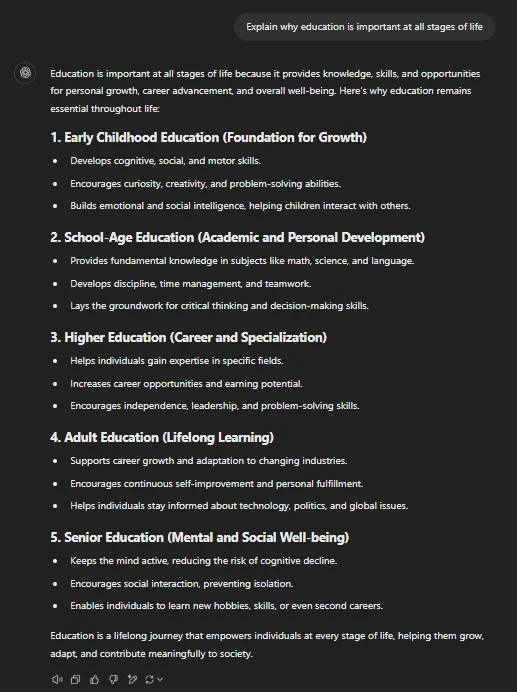
Meanwhile, DeepSeek came up with a more detailed and descriptive answer. The response also had more structure and included sections like the broader benefits of education.
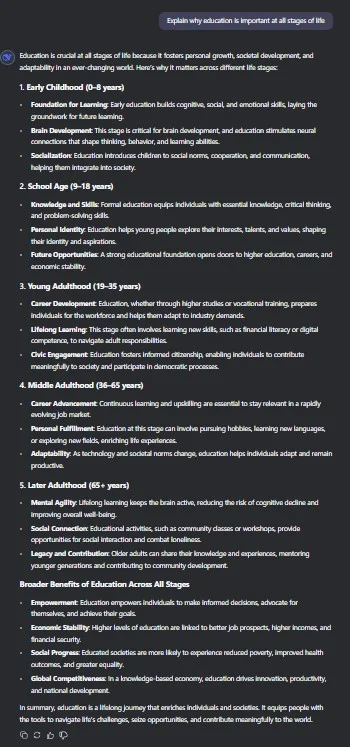
To me, DeepSeek gave me more information, explained the age groups, and wrapped up the query quite nicely. ChatGPT also fulfilled the query in a neat and concise way.
So, using this example as a reference, DeepSeek provides more details and structure, while ChatGPT focuses more on the key information and being concise.
Example 2 (Shorter Query):
For the 2nd example, I decided to go for a more simpler question like “Why is Pluto not a planet?”
Here is what ChatGPT and DeepSeek came up with.
ChatGPT came up with a simple answer explaining the three criteria that describe a planet. However, the response fails to address the fact that Pluto was reclassified as a dwarf planet at the start.
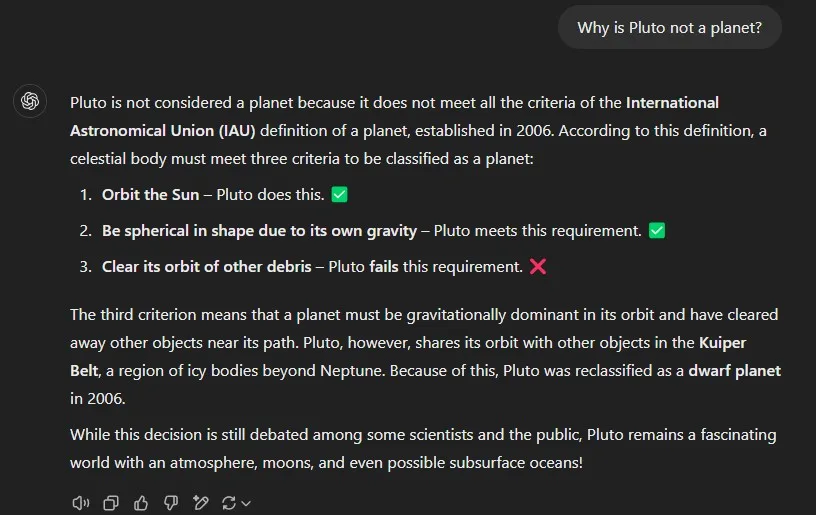
Meanwhile, DeepSeek provides a more detailed explanation and mentions at the very start of Pluto’s current designation.
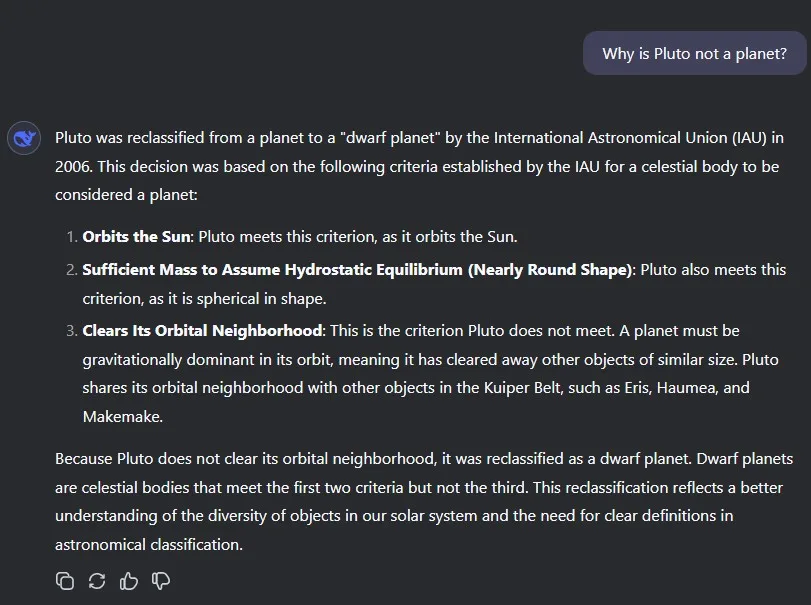
This example also highlights how DeepSeek answers in a more structured and detailed way while ChatGPT focuses on getting the main points across.
Verdict
Both examples highlight how DeepSeek provides more details and structure while ChatGPT gives simpler and more concise answers. So, for documentation and text, DeepSeek provides a better solution. So, this goes in favor of DeepSeek.
Code Generation
A huge point of contention is code generation, as developers have been using ChatGPT as a tool to optimize their workflow. With DeepSeek being introduced into the mix, the choice is not as straightforward.
To understand the code generation capabilities for both chatbots, I asked them to create a code to find all the prime numbers for a list of integers. Both models chose Python to generate their solutions.
ChatGPTs Result
GPT 4o Mini created a simple code to do the job. They also provided an explanation of the code with an idea of what the functions are and an example output. The code is neat, and it can be edited to suit your needs.
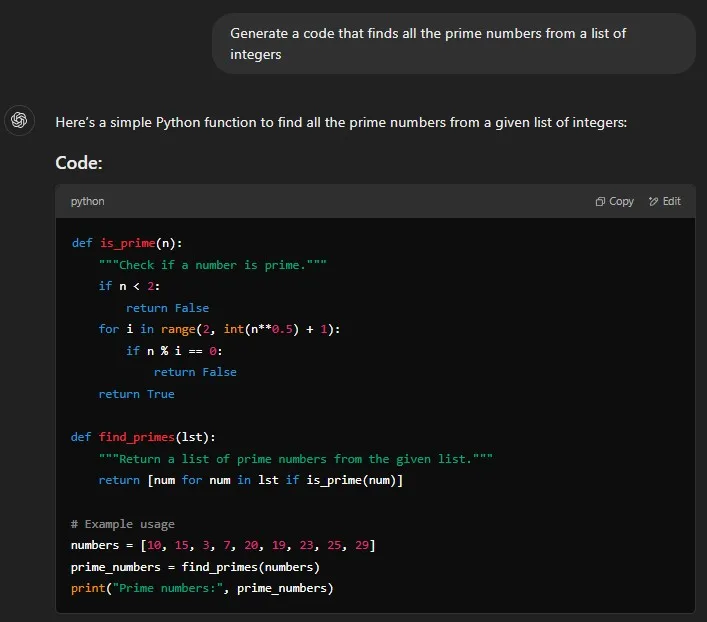
DeepSeek’s Result
On the other hand, DeepSeek R1 came up with a bit more details in the code. They added layers of conditions as opposed to the single condition in ChatGPT’s version. DeepSeek’s version works pretty well, but there is no room to edit it inside the chatbot. Also, the explanation of the code is more detailed.
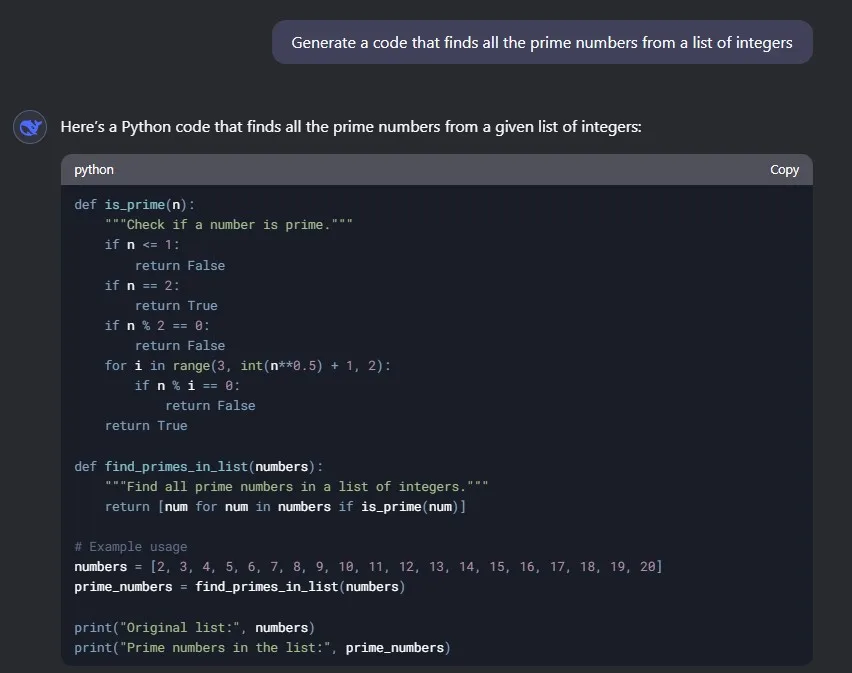
Verdict
ChatGPT comes up with a simple solution that any aspiring coder can understand. Meanwhile, DeepSeek provides a more in-depth solution to the problem that was asked. So, given the editability and comprehension of the code, I would consider this a draw.
User Experience
Both DeepSeek and ChatGPT look the same when you go to their app. However, ChatGPT is cleaner than DeepSeek is. Both now provide a search and reasoning option, and you can upload files to both models.
However, with ChatGPT’s accessibility features of being able to edit code, prompt with voice, and connect with Google Drive or Microsoft OneDrive, it is the superior solution in this regard. Thus, ChatGPT provides a better user experience.
Data Privacy
Lastly, there is data privacy, where ChatGPT seems to excel at this moment. DeepSeek is more stringent on information, especially regarding politics. However, that can be bypassed as R1 is open-source.
This does make DeepSeek more prone to data leaks. Hence, data privacy is a bit of a concern when it comes to this AI model.
Meanwhile, ChatGPT is closed source, and it complies with standard data protection protocols. So, given the nature of both models, ChatGPT is the more secure chatbot at this moment.
Pros and Cons of DeepSeek and ChatGPT
With their features explained, here are the pros and cons of both platforms.
Pros and Cons of DeepSeek
DeepSeek is a platform that excels at excellent technical query resolution as well as being cost-effective. However, that also has some cons as well. Thus, here are the pros and cons of DeepSeek.
|
Pros |
Cons |
|
Excellent For Coding and Technical Queries |
UI is Not Great |
|
Resolves Structured Queries With Speed |
Requires Technical Knowledge to Customize |
|
Open Source |
Strict Content Moderation |
Pros and Cons of ChatGPT
Similarly, ChatGPT excels at utilizing its massive knowledge base to answer all queries and portray that in a simple way. Hence, here are the pros and cons of ChatGPT.
|
Pros |
Cons |
|
Great For Idea Creation and Research |
Slow Resolutions for Technical Queries |
|
User-Friendly Platform |
Expensive to Use Due to API and Training Cost |
|
Capable of Generating Text, Image, Voice, etc. |
Free Version has Limitations |
Which AI Model to Use?
From the above categories that have been laid out and explained briefly, you can tell both DeepSeek and ChatGPT have unique advantages and disadvantages. So, let’s highlight in which cases and situations you should use either.
When to Use ChatGPT?
ChatGPT works best when you use the platform in the following situations.
- Idea Generation and Creativity: ChatGPT excels at providing ideas and creative solutions.
- For Images and Video: ChatGPT can generate images and videos for you, despite the functionality being limited.
- For Reports and Presentations: For the layman, ChatGPT is the better solution as it provides answers in a simple way. So if you are trying to execute a marketing strategy or trying to explain a concept, ChatGPT is better for you.
- For More Privacy: If you require more privacy as you are sharing sensitive data and such, ChatGPT is the better solution for you.
When to Use DeepSeek?
On the other hand, DeepSeek has different reasons why you should use it.
- For Technical Queries: DeepSeek is great at providing fast solutions for mathematical and coding solutions.
- For Comprehensive Solutions: Regardless of the type of query, DeepSeek provides an in-depth solution with proper explanation.
- For Customizability: DeepSeek is more customizable, and you can configure the app to your needs.
- For Cost Efficiency: DeepSeek is more cost-efficient as it is free to use and it’s open source. Also, the AI models are not hardware-intensive.
Key Takeaways
In short, both DeepSeek and ChatGPT provide different strengths and weaknesses. DeepSeek is more technical-oriented, while ChatGPT is better suited for general use.
Hence, for businesses, DeepSeek provides a more cost-efficient solution that is capable of handling technical problems with ease.
On the flip side, content creators and casual users will find more value in ChatGPT. Its ability to generate ideas and create concise content is a great way to learn more about a topic without being overwhelmed with too much information.
Thus, both R1 and 4o Mini have their uses, and this blog gives you a better idea of when to use either model and the strengths each platform gives.
Frequently Asked Questions
DeepSeek is more efficient and cost-effective than ChatGPT as it is an open-source model. Also, DeepSeek performs as good as ChatGPT in most topics if not all.
DeepSeek is better than ChatGPT when it comes to solving technical and mathematical questions. Also, DeepSeek is more cost-effective as it costs less to train the model using the API, and it has an open-source model.
After the release of DeepSeek R1, the AI model is considered the biggest competitor of ChatGPT.



